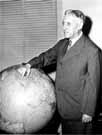
|
|
|

|

|

|

|
|
Click on an image to see a larger, more detailed picture.
|
|
|
|
|
| 1944: Desperate Acts |

|
pg. 546 |

|
|
|
|
| |
 The Nazis sought not only to exterminate every last Jew in Europe, but also to erase most evidence that the Jews ever existed. This photograph shows two Red Army soldiers inspecting a partially burned Torah scroll, a remnant of the culture the Third Reich sought to destroy. The scroll was found when Soviet troops liberated the Majdanek death camp.
The Nazis sought not only to exterminate every last Jew in Europe, but also to erase most evidence that the Jews ever existed. This photograph shows two Red Army soldiers inspecting a partially burned Torah scroll, a remnant of the culture the Third Reich sought to destroy. The scroll was found when Soviet troops liberated the Majdanek death camp.
Photo: Yad Vashem
|
 One of about 20,000 Gypsies registered in Auschwitz-Birkenau, a young woman is photographed in various mug shots. The Nazis' treatment of the young woman was determined in part by whether or not she was of "pure" or "mixed" blood. Those who were considered Mischlinge (mixed blood) ironically suffered more than those who were "pure" Gypsies, who were originally considered Aryans. Those housed in the family camp, perhaps this young woman among them, were sent to their deaths in the summer of 1944.
One of about 20,000 Gypsies registered in Auschwitz-Birkenau, a young woman is photographed in various mug shots. The Nazis' treatment of the young woman was determined in part by whether or not she was of "pure" or "mixed" blood. Those who were considered Mischlinge (mixed blood) ironically suffered more than those who were "pure" Gypsies, who were originally considered Aryans. Those housed in the family camp, perhaps this young woman among them, were sent to their deaths in the summer of 1944.
Photo: State Museum of Auschwitz-Birkenau/United States Holocaust Memorial Museum Photo Archive
|
 A few weeks after D-Day, Secretary of War Henry L. Stimson proudly points to Allied progress into Nazi-held territory. After visiting several war fronts, Stimson informed the American people in his radio address that victory was in sight, although the enemy was still fighting fiercely. Just how fiercely even Stimson probably could not conceive: Although D-Day did indeed mark the beginning of the Allied march toward the Fatherland, German troops would resist for another 11 torturous months. Egged on by Hitler, the retreating Waffen-SS and Wehrmacht often destroyed what they could not defend, depriving the Allies of housing and fuel and other materiel.
A few weeks after D-Day, Secretary of War Henry L. Stimson proudly points to Allied progress into Nazi-held territory. After visiting several war fronts, Stimson informed the American people in his radio address that victory was in sight, although the enemy was still fighting fiercely. Just how fiercely even Stimson probably could not conceive: Although D-Day did indeed mark the beginning of the Allied march toward the Fatherland, German troops would resist for another 11 torturous months. Egged on by Hitler, the retreating Waffen-SS and Wehrmacht often destroyed what they could not defend, depriving the Allies of housing and fuel and other materiel.
Photo: United States Holocaust Memorial Museum Photo Archive
|
|

|

|

|

|
 July 28, 1944: The Red Army captures Brest-Litovsk, Belorussia.
July 28, 1944: The Red Army captures Brest-Litovsk, Belorussia.
|
 July 29, 1944: 3520 Jews are forced on a death march westward from Warsaw. More than 200 die.
July 29, 1944: 3520 Jews are forced on a death march westward from Warsaw. More than 200 die.
|
 July 30, 1944: Three tankers, carrying some 1750 Jews from the Italian-held islands of Kos and Rhodes, arrive at Piraeus, Greece, where the Jews are bullied onto trucks and driven to the Haidar detention camp near Athens.
July 30, 1944: Three tankers, carrying some 1750 Jews from the Italian-held islands of Kos and Rhodes, arrive at Piraeus, Greece, where the Jews are bullied onto trucks and driven to the Haidar detention camp near Athens.
|
 July 30, 1944: More than 100 Jews are deported from Toulouse, France, to Auschwitz.
July 30, 1944: More than 100 Jews are deported from Toulouse, France, to Auschwitz.
|
 July 31, 1944: Among 1300 Jews deported from Drancy, France (northwest of Paris), to Auschwitz are 258 Jewish orphans seized in and around Paris on July 24. Upon arrival at the camp, all 500 children and 300 adults are gassed. This is the last transport of Jews from the Drancy camp to Auschwitz. In total, 73,853 Jews have been shipped from Drancy to their deaths at Auschwitz and Sobibór.
July 31, 1944: Among 1300 Jews deported from Drancy, France (northwest of Paris), to Auschwitz are 258 Jewish orphans seized in and around Paris on July 24. Upon arrival at the camp, all 500 children and 300 adults are gassed. This is the last transport of Jews from the Drancy camp to Auschwitz. In total, 73,853 Jews have been shipped from Drancy to their deaths at Auschwitz and Sobibór.
|
|
|
|
|
| 1944: Desperate Acts |

|
pg. 546 |

|
|
The Holocaust Chronicle
© 2009 Publications International, Ltd.
|
|
